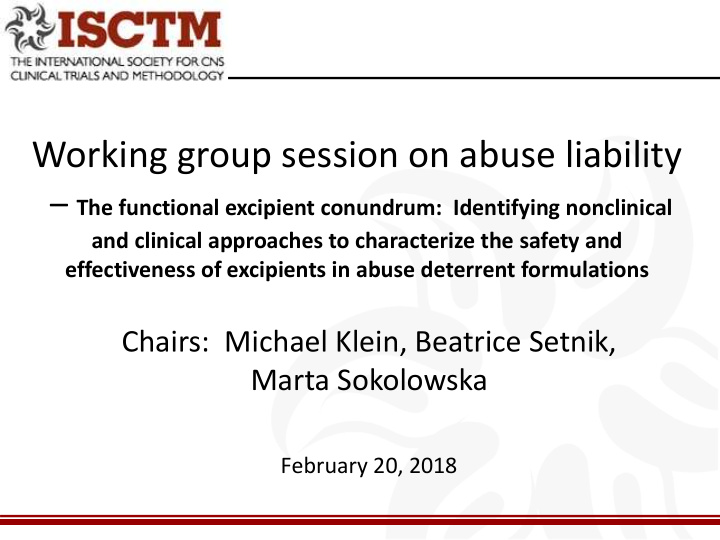



Working group session on abuse liability – The functional excipient conundrum: Identifying nonclinical and clinical approaches to characterize the safety and effectiveness of excipients in abuse deterrent formulations Chairs: Michael Klein, Beatrice Setnik, Marta Sokolowska February 20, 2018
Working Group Discussion 1. Regulatory history * 2. Regulatory guidance 3. Use and function of excipients in oral opioid abuse deterrent formulations 4. Safety issues related to excipient harms *(https://www.fda.gov/downloads/AdvisoryCommittees/CommitteesMeeting Materials/Drugs/AnestheticAndAnalgesicDrugProductsAdvisoryCommittee/ UCM569139.pdf)
Participants Baker Angela bakerangela@prahs.com Detke Mike mjdetke@gmail.com Friedrich Deanna deanna.friedrich@camcog.com Hovland Jason jhovland@cnssites.com Klein Michael michaelklein788@gmail.com Liu Wei Wei.Liu@fda.hhs.gov Setnik Beatrice beatrice.setnik@incresearch.com Sokolowska Marta msokolowska@depomed.com Stonehouse Matt mstonehouse@hritrials.com Suessmuth Sigurd sigurd.suessmuth@boehringer- ingelheim.com Umhau John John.Umhau@fda.hhs.gov Webster Lynn websterlynn@prahs.com Weston Vanessa westonvanessa@prahs.com
Abuse deterrence 1. Opioid pharmaceutical products are formulated such that their physicochemical properties may reduce, deter or prevent abuse and contribute to decreases in morbidity and mortality from opioid abuse. 2. Changes in the formulation are intended to deter abuse, inadvertent overdose, and misuse of products that can come about by inappropriate manipulation of the product and administration of the active pharmaceutical ingredient (API) by alternate routes of administration. 3. FDA guidance speaks to the need for innovation and flexibility in the development of “abuse deterrent” opioid products.
Issues Discussed 1. Excipients intended for oral use are generally not evaluated by non-oral routes for abuse. Safety issues and possible studies to were discussed. 2. Unintended consequences of the ADF products: One form of abuse can be substitution of one form of abuse for another, that is change from IN to IV abuse. Market withdrawals of ADFs have been precipitated by a few dozen localized cases of serious harms. 3. Product Labeling: Doesn’t reach abuser; people inject solutions made from oral products, even when labeled as dangerous to do so. Abusers over time often move from less dangerous routes (i.e. oral) to more dangerous routes (i.e., injection) 4. Aversive agents are less attractive to manufacturers: Patient burden, toxicity. Likelihood of approvability appeared low; SLS is only excipient to move forward to market in an opioid formulation
Increased Safety Concerns 1. We must assume that all opioid products will be administered by injection: 15-20% of deaths reported to PCC involve drug injection. 2. Injection persists even with ADF products, showing the need for continued innovation in making better analgesics and better ADF product components 3. Risk of death and adverse events is greater when intravenous route is used. 1. 6% of HIV diagnoses and 10% of AIDS cases attributed to IV drug use in 2015. 2. Other health risks of injection: Hepatitis C, Endocarditis, Blood clots
Lessons Learned 1. Safety of excipients is integral to approval 2. Intended and unintended routes of administration are considered 3. Exposure with high therapeutic doses needs to be evaluated for safety for the patient and the drug abuser.
Recommend
More recommend